Astonishing X-Men, Moonstruck, Generation Gone & More in Required Reading: Comics for 7/19/17
Main Art by Jim Cheung Comics Lists Required Reading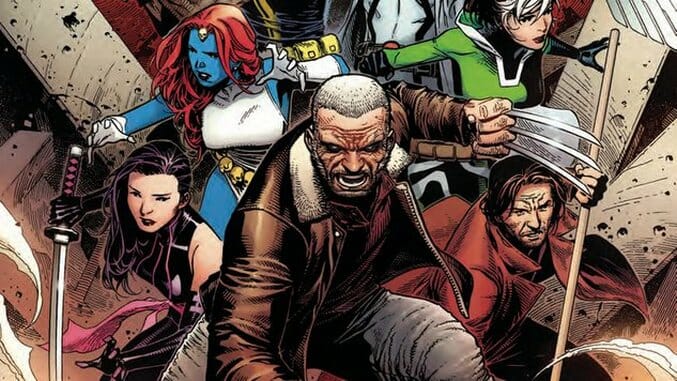
July is ricocheting past like a sweaty bat out of Hell, and you know what that means: San Diego Comic-Con is just around the corner, primed to flood our feeds with new comic announcements, high-profile movie and TV news and a fleet of instantly sold-out collectibles that will fetch insane markups on eBay. While SDCC is an important mid-summer marker that often brings the biggest comic news of the remainder of the year, most of us probably aren’t planning to trek out to California this coming weekend, which will leave plenty of time for reading this week’s new comic releases. Marvel leads the pack with its latest Astonishing X-Men volume, this time eschewing one A-list artist for a fleet of rotating premiere pencilers. Former Marvel bad boy Ales Kot returns with a new Image series, Jason Shiga’s blackly humorous Demon continues, Moonstruck brings a popular fan-fiction format to print, Dark Horse imports Lovecraft manga, James Bond tackles a too-real Russian plot and DuckTales returns to comics in style. If you’re headed to SDCC: god speed. If you’re kicking it locally, kick back with one of these quality reads.
 Astonishing X-Men #1
Astonishing X-Men #1
Writer: Charles Soule
Artist: Jim Cheung
Publisher: Marvel Comics
X-Men Gold was positioned as the flagship X-book for this new era, only to be quickly supplanted by the announcement of Charles Soule on Astonishing X-Men with a rotating crew of A-list artists including Phil Noto and Ron Garney. While the opportunity to see grandmasters like launch artist Jim Cheung contribute to the X-Men universe is welcome, the lack of a consistent visual identity may hamper the book’s ability to attract and maintain a steady readership—especially among new and casual readers who may not anticipate following a book that looks drastically different month to month. That pitfall aside, Soule has been one of the few bright spots in the recent X-Men history, scripting the shockingly good Death of Wolverine and Death of X mini-series, and Cheung is among the most polished practitioners of straightforward superhero art currently contributing to Marvel. Soule has assembled an eclectic squad of mutants—essentially a fan-favorite grab bag of characters who’ve been off the table for a bit, from Gambit to Mystique to Bishop, led by Old Man Logan against the Shadow King, the psychic threat who returned to prominence recently as the big bad in FX’s Legion series. The X-Men are undoubtedly in a better spot than they were a year ago, but the franchise still has a long way to go to reclaim earlier glories. Fingers (and claws) crossed that Soule can help get them there. Steve Foxe
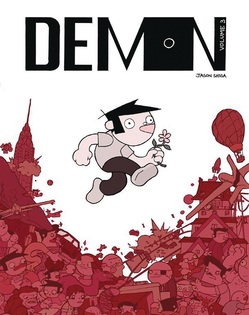 Demon Vol. 3
Demon Vol. 3
Writer/Artist: Jason Shiga
Publisher: First Second
Just last week, Paste praised publisher First Second for its collection of winsome, creative kids comics from Ben Hatke, Maris Wicks and Jame Kochalka. Lest we pigeonhole, their line also includes notable work about a man whose consciousness slips into a new body every time he commits graphic suicide. Through two volumes, Jason Shiga’s Demon has remained caustically intelligent, funny and mildly sociopathic. It also has a strong base in math and logistics, because Shiga studied them at Berkeley and why the hell not? Moral qualms aside, Shiga’s uncompromising vision only deepens in absurdity—a ridiculous and artful cartooning algorithm from which you can’t look away. All of his strips were once available online, but have permanently segued to these editions. The linework is stylized and thick, adept at rendering mutilation and tedium with equal and intentional indifference. Suffice to say, Shiga probably isn’t religious or even a secular humanist. Whether you enjoy it or not, Demon is bloody, intelligent fun and unlike any other comic available. Sean Edgar
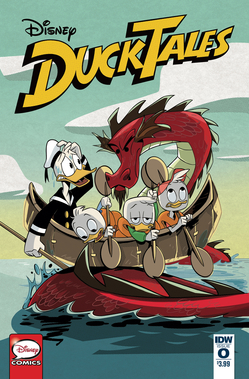 DuckTales #0
DuckTales #0
Writer: Joe Caramagna
Artists: Paolo Campinoti, Andrea Greppi, Gianfranco Florio
Publisher: IDW Publishing
The relaunched DuckTales cartoon debuts August 12th with a sterling cast that includes David Tennant, Kate Micucci, Ben Schwartz, Danny Pudi and Bobby Moynihan, and IDW’s licensed comic hints at the mallard mischief to ensue. Though leading duck Uncle Scrooge may be most recognized as a Gen X icon for his ‘80s cartoon, his most legendary adventures arose in iconic comics from cartoonist Carl Barks and his successor, Don Rosa. (Publisher Fantagraphics has done a fantastic job collecting those runs.) New writer Joe Caramagna retains the eclectic adventure of a strip that helped inspire Raiders of the Lost Arc in this new outing. This zero issue offers two yarns: the first strands Donald and his nephews on an island surrounded by dangerous sea sponges, with a second that introduces the waterfowl analogue of suspense pioneer Alfred Hitchcock. Scrooge doesn’t pop up from his money pit quite yet, but the trio of artists nicely channels the angular redesigns of the upcoming show. The scripts also contrast Donald’s paternal (and terrified) demeanor against Huey, Dewey and Louie’s ornery brotherhood. With a strong emphasis on family and escapism, this comic prepares for more derring-do, bad- and good-luck tales. Sean Edgar
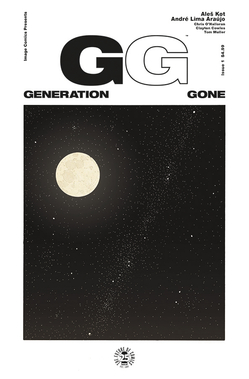 Generation Gone #1
Generation Gone #1
Writers: Ales Kot, André Lima Araújo
Artist: André Lima Araújo
Publisher: Image Comics
Ales Kot has never shied away from political or cultural commentary in his comics. In an industry in which other creators routinely flub how they confront modern social issues, Kot has routinely pushed those same problems to the forefront of his writing. His perspective makes him perhaps the perfect person to spearhead a book like Generation Gone, in which the dreaded millennial gets superpowers. Generation Gone certainly isn’t the first book to ask the question of what a young superhero looks like, but it’s still rare to see one who lacks believable financial, social and political stability the way a lot of actual young people do. The biggest suspension of disbelief in cape-and-cowl comics isn’t superpowers anymore, but the lack of student loan stress. André Lima Araújo’s detailed, focused art is a great fit for a book that’s both character-focused and high-flying, and colorist Chris O’Halloran gives the book a poppy, electric vibe. Think of this as if Hackers had a lovechild with the British show Misfits, hell-bent on destroying golf or department stores or whatever relic think-pieces claim the youth are “killing” this week. Caitlin Rosberg
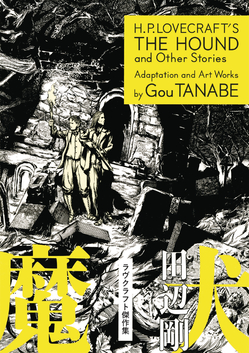 H.P. Lovecraft’s The Hounds and Other Stories #1
H.P. Lovecraft’s The Hounds and Other Stories #1
Writers: H.P. Lovecraft, Gou Tanabe
Artist: Gou Tanabe
Publisher: Dark Horse Comics
For all of H.P. Lovecraft’s tentacle-waving impact on pop culture, his actual writing is much more concerned with mounting dread and paranoia than with looming great beasts or complex characters, which is why straight adaptations are much rarer than homage: why stick to the slow madness when you can break out Cthulhu? Gou Tanabe is one of a handful of cartoonists, like British artist I.N.J. Culbard, to tackle Lovecraft stories faithfully, albeit with traditionally handsome manga protagonists rather than the more harried figures you’d expect from a tale of claustrophobic insanity. Dark Horse is the first U.S. publisher to import Tanabe’s work, and hopefully this first collection with pave the way for the rest of the artist’s Lovecraft series. Too-pretty protagonists aside, Tanabe renders densely detailed scenes full of uneasy shadows, punctuated by moments of abject monstrousness. While horror manga like I Am a Hero and Junji Ito’s classic output benefit from better-realized characters, Tanabe’s take on Lovecraft is a strong tribute to the genre luminary and a fascinating look at how weird fiction can translate to other media. Steve Foxe
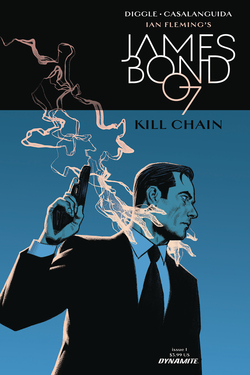 James Bond: Kill Chain #1
James Bond: Kill Chain #1
Writer: Andy Diggle
Artist: Luca Casalanguida
Publisher: Dynamite Entertainment
While no other Bond comic writers have quite hit the heights of Warren Ellis’ blockbuster two-arc run with Jason Masters, Dynamite’s handling of the license has been an all-around success, pushing an iteration of James Bond who stands comfortably at the crossroads of the franchise’s un-self-conscious spy thriller roots and Daniel Craig’s ball-busting modern portrayal. Andy Diggle returns for another tour of duty alongside artist Luca Casalanguida in Kill Chain, which revives an Ian Fleming creation mostly absent from the films: SMERSH, a Russian counter-intelligence agency modeled after the KGB and a real-life group that operated briefly in the ‘40s. SMERSH, despite a title that does not sound intimidating in English, seeks to undermine NATO and pit Bond’s British handlers against the CIA. Russia meddling in international affairs and the U.S. potentially pulling out of NATO? On second thought, file this one under “too close to home.” Steve Foxe
 Kill the Minotaur #2
Kill the Minotaur #2
Writers: Chris Pasetto, Christian Cantamessa
Artist: Lukas Ketner
Publisher: Skybound/Image Comics
Last month, Walking Dead imprint Skybound introduced a comic about Greek beasts that was far more Clive Barker than Ray Harryhausen. Written by Chris Pasetto and Christian Cantamessa with illustrations by Lukas Ketner, Kill the Minotaur merges classic myth with modern gore without coming across as exploitive. But in all honesty, was the story of a human/bull hybrid devouring virgins in a maze ever anything but nightmare fuel? This second issue escalates that visceral terror by introducing a labyrinth that’s as much a character as headstrong prince Theseus or the despotic King Minos. Lukas Ketner constructs a shifting geographic monstrosity that teeters between grotesque and elegant in a panel, rippling with veins and curiosity. This intoxicating setting will fuel intrigue for this miniseries, keeping the reader in thrall of what new fantasy-horror vistas lay a page away…and may hide a glimpse of the titular atrocity. Sean Edgar
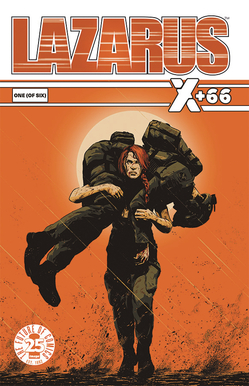 Lazarus X+66 #1
Lazarus X+66 #1
Writers: Greg Rucka, Eric Trautmann
Artist: Steve Lieber
Publisher: Image Comics
Greg Rucka and Michael Lark’s Lazarus is one of the most consistent sci-fi titles under the Image umbrella right now, with a focused future class-war saga interweaved with Rucka’s copious research into the future of genetic engineering and our growing political and financial divides. As the main book takes a break to gear up for its next arc, Rucka has gathered six creative teams to tell standalone stories set in the year +66, starting with frequent Rucka cowriter Eric Trautmann and The Fix artist Steve Lieber. It’s rare to see creator-owned titles inviting other voices into the mix. But opportunities like this mini-series, James Harren’s recent issue of Seven to Eternity and The Wicked and the The Divine’s guest artists lift Marvel/DC scheduling tactics in fun, thoughtful ways, with artists who add to the established visual identities of these standalone universes. If you’re a longtime Lazarus fan, you won’t want to miss this six-issue aside. If you’re new to Rucka and Lark’s story, now’s the time to catch up. Steve Foxe
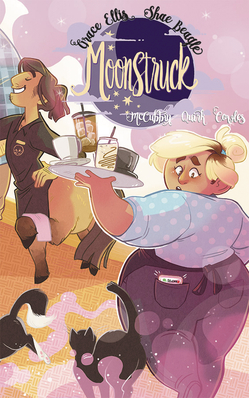 Moonstruck #1
Moonstruck #1
Writer: Grace Ellis
Artists: Shae Beagle, Kate Leth
Publisher: Image Comics
Grace Ellis, one of the minds behind Lumberjanes, returns to comics with a title that sounds like all the best parts of fan-fiction. Moonstruck is the coffee-shop AU a lot of readers will find familiar: a queer-friendly supernatural story starring a werewolf barista who’s just trying to have a normal life, surrounded by humans and other magical creatures alike. Ellis has a skill for writing fun, frothy stories with a lot of heart, and she’s teaming up with Shae Beagle, a relative newcomer to print comics with a sizable online following. Beagle’s style is cutesy and rounded, but very expressive, which suits a book like Moonstruck. Since the start of Lumberjanes, Ellis has worked with teams of skilled women for both the main title and backup stories, and there’s no reason to think Moonstruck will be any different, as cartoonist Kate Leth contributes shorts for the opening arc. Fans of Moonstruck should also check out the Eisner-nominated Deja Brew by Taneka Stotts and Sara DuVall, further proof that the liminal spaces of cafes and bistros are perfectly suited to comics with a lot of heart and beautiful art. Caitlin Rosberg
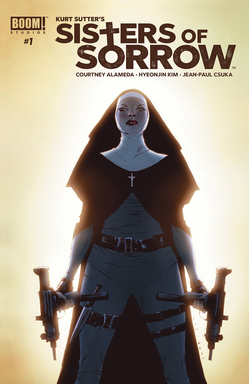 Sisters of Sorrow #1
Sisters of Sorrow #1
Writers: Kurt Sutter, Courtney Alameda
Artist: Hyeonjin Kim
Publisher: BOOM! Studios
Kurt Sutter and Courtney Alameda are no strangers to sharp, violent storytelling. Sutter is probably best known for his work on Sons of Anarchy, but he’s also worked on The Shield, and last year launched a six-issue miniseries at BOOM!, Lucas Stand. Alameda has written supernatural horror, including her debut novel Shutter, and earned a following of her own. The two are pairing up to tell the story of four women who do their best to save other women in need, running a women’s shelter by day and enacting street justice on the night shift…while wearing nun habits. It’s exactly the kind of vengeance-and-violence story that Sutter excels at, complemented by Alameda’s skill at writing layered, complex protagonists. Artist Hyeonjin Kim is a relative unknown, but likely won’t be for long after this book. Kim has a flare for dramatics without robbing characters of interesting features and expressions. Caitlin Rosberg